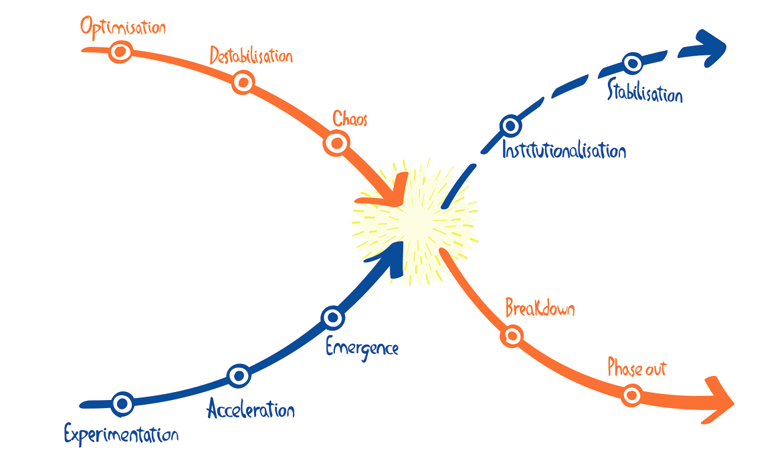What is transformative change?
‘Transformation’ is generally defined as a marked change in form or nature. The type of transformation discussed here involves change to the structure of the economy.
On this page
This type of transformation is not new – the structure of the economy is always changing and has undergone periods of significant change in the past such as in the Industrial Revolution.
What is new is the pace of structural change that is happening, or needs to happen, in response to anthropogenic climate change, biodiversity loss and other planetary stresses.
Transformative change involves long-term, complex processes which entail much risk and uncertainty. The process of transition from the current to future state can be described by 2 interrelated patterns: breakdown and build-up – see Figure 1. Innovation plays a key role in the build-up process. But forces such as path dependence and vested interests work to preserve the status quo.
Policy can act as an enabler, set the direction of and shape transitions, and help avoid system failures. But achieving (and analysing) transformative change is hard. Transformative change involves action today in a world in which future preferences, risks and opportunities are fundamentally unknown.
Figure 1: X-Curve of transition dynamics

Source: Silvestri, Diercks, & Matti (2022), X-Curve: A sensemaking tool to foster collective narratives on system change
Text description: X-Curve of transition dynamics
Features of transformative change
The features of transformative change as discussed in this paper include:
- Goal-oriented – deliberate policy action towards specific goals.
- Long-term and future-focused – the future may look very different from the past.
- Systemic – involving widespread effects, and intervention points, across systems.
- Risk and uncertainty – the future is unknown and involves risk (which can be assigned a probability) and uncertainty (which cannot).
- Innovation – which is cumulative, highly risky, subject to occasional large discontinuous shifts and systemic.
- Path dependence – past events or decisions may constrain later ones; history matters.

